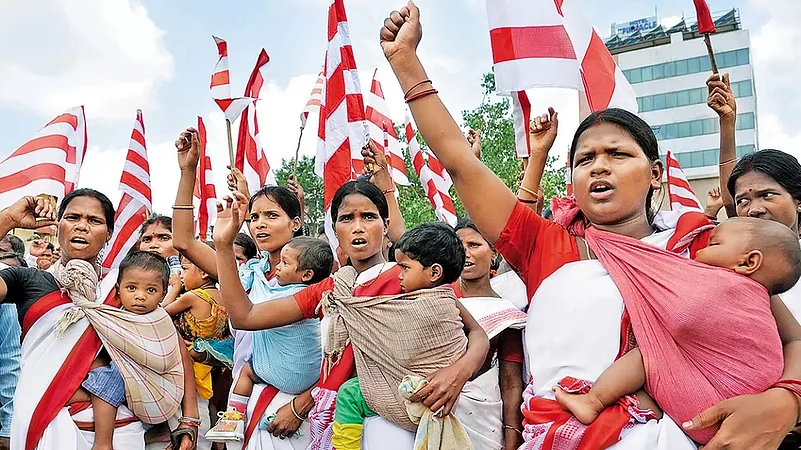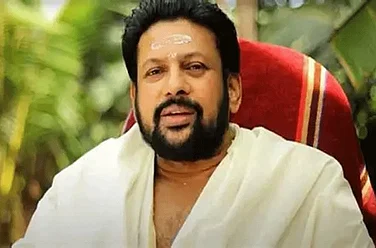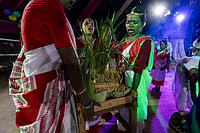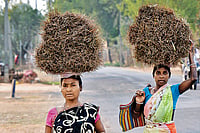The village of Polpol Path in Jharkhand, about 200 km west of the state capital of Ranchi, does not have a hospital. It does not have a good road connecting it to the rest of the state, either. The 135 households have to fetch the ration distributed by the government from Dumar Path, about 4 km away. They also do not benefit from the Birsa Awas Yojana, a housing scheme for tribal communities started in 2004.
Polpol Path, however, is not an isolated case. Other neighbouring villages such as Sakhuapani, Korkot Path, Jobhi Path and Gora Pahaad also bear testimony to the deprivation the Asurs are facing. There are 32 tribal communities in Jharkhand, out of which eight are on the verge of extinction, like Asurs. According to the 2011 Census, out of a population of 329.88 crore, 86.35 lakh in Jharkhand were Adivasis. Of these, 2,92,359 are primitive tribes and Asurs number 22,469. Categorised as vulnerable, the government initiative to protect their language, culture and traditions is not helping the Asurs.
“Our culture is changing every day,” says Vimal Chandra Asur, 40, president of the Adim Janjati Yuva Manch, an organisation of the tribal youth. “As our religion and culture are not powerful enough, people are converting to other religions.” Many from the community, however, believe that one way of keeping the community together is Sarna, their own religion.
History of ‘Holy Woods’
Sarnaism is a religious tradition that revolves around the worship of trees and other natural elements. James B. Minahan, a scholar of identity, in his book, Ethnic Groups of South Asia and the Pacific, writes that the word ‘sarna’ means grove or holy woods. In the Chhota Nagpur Plateau region of Jharkhand, West Bengal, Odisha, Bihar and Chhattisgarh, many people from Adivasi communities follow Sarnaism. “Our rituals, festivals and rites such as marriages are different from Hinduism,” says religious leader Bandhan Tigga. “We worship nature.” A prominent advocate of the official recognition of Sarnaism, Tigga adds, “Idolatry and the (caste) system do not exist among us. There is no discrimination between men and women.”
There has been a strong demand for recognition of Sarnaism in the state. In the 2011 Census, 49.57 lakh people wrote Saran as their religion, out of which 42.3 lakh hailed from Jharkhand alone. In all, 79 lakh denoted their religion under the column ‘Other’. Supporters of Sarnaism claim that many of these were followers of Sarna. India recognises 705 Scheduled Tribes spread across 21 states in the country, comprising about 8.6 per cent of the total population or about 10.4 crore. If Sarnaism is given official recognition, the number of its followers could be as high as 5 crore, says Tigga.
Karma Oraon, a retired professor of anthropology from Ranchi University, has studied the Sarna movement for years. “The religion traces its roots to ancient times and the tradition continued over generations,” he says. “The demand for giving Sarna official recognition is five decades old and the movement got stronger when the youth began to back it.”

Adivasis and the Politics of the RSS
As soon as he assumed office the second time in December 2019, Jharkhand Chief Minister Hemant Soren stressed the importance of providing official recognition to Sarna. The state Assembly unanimously passed a resolution calling for a religious code for Sarnaism at a special session on November 11, 2020. The resolution was sent to the Centre, which has the power to recognise a religion. With Droupadi Murmu, a Santhal from Odisha, becoming the first President of India from the Adivasi community this year, the community has high hopes that they will be heard.
However, the issue has led to a war of words between the Bharatiya Janata Party (BJP) at the Centre and the Jharkhand Mukti Morcha (JMM) in the state. On June 8, Soren tweeted asking why the BJP was silent on this issue. JMM general secretary Supriyo Bhattacharya says, “After passing the resolution, we met the Central government. We were promised the proposal would be seriously considered. We do not know what progress it has made, but we will soon meet the President. As an Adivasi, she is connected to Sarnaism. If the Centre refuses to act, we are ready to launch a struggle to achieve this objective.”
The Central government, sources say, is dragging its feet owing to stiff resistance from the Rashtriya Swayamsevak Sangh (RSS), its ideological fountainhead. “Sarnaism is part of the Sanatana Dharma,” says Hirendra Sinha, regional organising secretary of Jharkhand Vanavasi Kalyan Kendra, an RSS affiliate. “Historically, we have been one. Jainism, Buddhism and Sikhism are also part of the Sanatana Dharma. The people who talk of conversion into Hinduism are wrong, because we do not consider Adivasis distinct from us. They worship nature just like us. There is no difference. However, as soon as they join other religions, like Christianity and Islam, their traditions and culture change.”
Though Sinha insists they would not object if the code is announced, he rejects the demand for a Sarna code as a conspiracy to divide the tribes. His organisation is planning to reach out to Adivasis and urge them not to demand a separate religious code.
Roadblocks Ahead
Getting the Sarna code might not be as easy under the Constitution. In 2015, an Adivasi delegation from Jharkhand submitted a charter of demands, which included a Sarna code, to the prime minister and the home minister. In reply, the office of the Registrar General and Census Commissioner of India said that it was not possible to add a new religion to the Census. The reply also said that the 2011 Census had recorded information on over 100 tribal religions. If Sarnaism was recognised as a separate religious identity, other tribes could also demand their own religion. Such disagreements could hamper the process.
It is not only the RSS and the BJP which are against such a separate code for the Adivasis. The Soren government had to change the nomenclature of the bill from the Sarna or Adivasi Religious Code Bill to the Sarna Adivasi Religious Code Bill after the Congress, his alliance partner, opposed it. The Opposition BJP’s objection to it was on expected lines. Soren gave a call for Adivasis across the country to unite and ensure that the Central government recognised the code.

Leaders of Adivasi groups in different states largely agree and praise Soren’s bold initiative. However, they seem to disagree on the name of the separate religious code for Adivasis. Noted Adivasi intellectual Ram Dayal Munda may have anticipated this debate long ago and suggested the name ‘Adi-dharma’—ancient/indigenous religion—in his book of the same name. There have been repeated demands for an Adivasi religious code, just like Sarnaism. These differences could arise in future, too, because Adivasis are not a homogeneous ethnic group. They include Bhils, which are around 2 crore, followed by around 1.6 crore Gonds, 80 lakh Santhals, 42 lakh Oraons, 27 lakh Mundas and 19 lakh Bodos. In Chhattisgarh, the Gonds consider their religion to be Gondi, while the Bhils and the tribals in the northeastern states also assert their separate identities.
Is unanimity on the term Sarna a challenge among Adivasis? Oraon responds, “There may be many folds in Adivasi society, just like other religions. Let the Gonds and Bhils raise their demand for their separate religions, and let them be recognised too. We do not object to that. All these religions would be Adivasi religions. But the truth is that Adivasis spread over 21 states, including a large part of central India, demand Sarnaism, which is a major entity now and which people have accepted.” Oraon believes that if the Sarna religious code is accepted by the government, it would trigger the ‘ghar wapsi’—reconversion—process among those Adivasi communities who have embraced other faiths and they would return to the Sarna fold.
Gladson Dungdung, a journalist and Adivasi ideologue, backs the Sarna code. He says, “In the first Census after Independence, Adivasis were incorporated in the Hindu column as part of a conspiracy to destroy their independent identity. This was a kind of genocide against nature-worshipping Adivasis. I believe that Soren’s decision brings justice, even if delayed, for Sarnaism followers.” It is their fundamental right and they should be granted their separate religious identity, he adds.
Their Dwindling Numbers
The Jharkhand government has argued that the Sarna religious code is needed to stop the decline in Adivasi population. In the resolution sent to the Centre, the government raised a valid point when it said that the population of Adivasis in Jharkhand has dwindled from 38.3 per cent in 1931 to 26.02 per cent in 2011. One of the reasons behind this sharp decline is not having a religious code. According to the advocates of Sarnaism, many Adivasis have converted to Christianity, Hinduism and Islam due to the lack of recognition, forgetting their heritage.
Christian missionaries in the state, however, support the demand for a Sarna religious code. Theodore Mascarenhas, the Catholic Bishop in Ranchi, says, “I welcome the proposal for Sarna religious code and we demand that the code be granted to the Adivasis. It is their right. The Sarna code is important for their identity and culture.”
One cannot deny that conversion among Adivasis is a reality. In some northeastern states, a sizeable tribal population has converted to Christianity. In Jharkhand, a larger section of the Adivasis follows Hinduism. According to information provided by the government under the RTI Act to advocate Dipti Horo, if you take out Sarnaism followers, 32,45,856 Adivasis in the state identify themselves as Hindus, followed by 13,38,175 Christians, 18,107 Muslims, 2,496 Buddhists, 985 Sikhs and 381 Jains. There are 25,971 Adivasis who do not follow any religion.
Assertion of Adivasi Identity
Ever since Soren took over the reins, his government has taken several decisions in favour of Adivasis. One such decision was the new domicile policy, which uses 1932 land records as a benchmark to define a local. His government also did not re-notify the Netarhat field firing range for the military, as the range has displaced thousands of Adivasis.
Dungdung believes that the Sarna code, Netarhat field firing range and domicile policy based on 1932 Khatiyan are issues related to each other. He says, “From the perspective of land, forest and water, Soren has taken these decisions in the interest of the Adivasis and they stem from Sarnaism and its core belief in nature.” In an oblique reference to Murmu, he laments that an Adivasi President has refused to utter a word about the Sarna code.
There are no clear answers yet. Soren believes that the Sarna code is necessary to preserve the environment, nature, forest and mountains against pollution and erosion. Thus, it becomes an issue linking Jharkand’s survival with the issue of land, water and forest. According to the Jharkhand Jungle Bachao Andolan, around 75 lakh people in the state fully depend on forests for their livelihood and are beneficiaries of the Forest Rights Act. However, the number of people granted land deeds by the government under the act is less than a lakh.
While passing the Sarnaism resolution, Soren had said that a nationwide campaign would be launched under the leadership of the Jharkhand Tribal Advisory Committee to build consensus on the code. The aim is to get other states to pass similar resolutions as a pressure tactic to bring the Centre around. The tribal advisory councils, established in all states with a sizeable Adivasi population, are constitutionally equipped to make decisions. The next census report, which might spring some surprises, is nowhere in sight. Given the Centre’s reservations on the issue, it is a long haul for the votaries of Sarna before the code becomes a reality.
(This appeared in the print edition as "Turning to their Heritage")
(Translated by Iqbal Abhimanyu. Views expressed are personal)
Md. Asghar Khan is a Jharkhand-based independent journalist



























